Summary
The summary, known as stats in Generation I and II games, and as check summary from Pokémon: Let's Go, Pikachu! and Let's Go, Eevee! onwards (Japanese in all generations: つよさをみる check strength), contains information about a Pokémon. It is accessed from the party and battle screens.
The summary is divided into multiple screens, for different kinds of information. In Generation I only, the game will always display both Stats screens of a Pokémon (in order) before returning to the party screen, and it is not possible to switch directly between the Stats screens of different Pokémon. Starting from the Generation II games, it is possible to press up and down to check the previous and next Pokémon, as well as press left or right to choose between different summary screens.
Starting from Generation IV, there is also a different version of the summary screen, with less information, when viewed during a battle.
Available information
This is the information available in the summary screen in all core series games.
| Game | RBY | GSC | RSE | FRLG | DPPt | HGSS | BW | B2W2 | XY | ORAS | SM | USUM | PE | SwSh |
|---|---|---|---|---|---|---|---|---|---|---|---|---|---|---|
| Nickname, species, type, OT, OT ID, level, experience, experience required to level up, HP (current and maximum), stats, status condition, list of moves and their PP |
✔ | |||||||||||||
| National Pokédex number | ✔ | ✘ | ||||||||||||
| Regional Pokédex number | ✔ | ✘ | ✔ | |||||||||||
| Gender symbol, held item, Pokérus symbol |
✘ | ✔ | ||||||||||||
| Shiny symbol | ✘ | ✔ | ✘ | ✔ | ||||||||||
| Nature, Ability, markings, Poké Ball, meeting area, meeting level; move's type, power, accuracy, and description |
✘ | ✔ | ||||||||||||
| Move's condition, appeal, and Contest or Super Contest description |
✘ | ✔ | ✘ | ✔ | ✘ | ✔ | ✘ | |||||||
| Move's jamming | ✘ | ✔ | ✘ | ✔ | ✘ | |||||||||
| Ribbons, characteristic, and meeting date; move's category |
✘ | ✔ | ||||||||||||
| Condition | ✘ | ✔ | ✘ | ✔ | ✘ | |||||||||
| Sheen; flavor liked | ✘ | ✔ | ✘ | |||||||||||
| Shiny Leaf | ✘ | ✔ | ✘ | |||||||||||
| Dynamax Level | ✘ | ✔ | ||||||||||||
Nickname
A Pokémon with no nickname is known by its species. In addition, there is a separate field specifically for the Pokémon species in all games, therefore the species appears twice for a Pokémon with no nickname.
Pokédex
In Generation II, the only Pokédex number displayed in the summary is from the Old Pokédex (later known as National Pokédex). In other games prior to Generation VII, the regional Pokédex number appears in the summary screen until the player receives the National Pokédex. From that point onward, the National Pokédex number appears instead. However, this has no effect on Pokémon available in the Kanto-based games, because their Kanto Pokédex number matches their National Pokédex number.
Moves
In Generation I and II, the stats screen includes a simple list of moves; only the move's name, current PP and maximum PP is shown.
In Generation II only, there is also a "move" (Japanese: つかえるわざ usable techniques) option accessible from the party, which is larger and more detailed than the list of moves found in the stats screen. The move option displays the moves' type, power, and text description as well (but not their accuracy, unlike later games).
From Generation III onwards, the list of moves is more detailed. It includes the moves' type, power, accuracy, and text description. From Generation IV onwards, it also displays the move's category (physical, special, or status move).
In the Hoenn and Sinnoh-based games, there are two separate move screens: one displays battle properties of moves as usual, and the other displays their properties when used during {{pkmn|Contest}s} or Super Contests, which includes the moves' condition and appeal. Only in the Hoenn-based games, the move's jamming is shown in the summary as well.
Ordering moves
From Generation I to Generation III, the player may change the order of moves by pressing Select at the list of moves during battle.
In Generation II only, a separate "move" option accessed from the party also allows the player to change the order of moves.
From Generation III onwards, the player may use the summary screen to change the order of moves.
Area and level met
In Pokémon Crystal, the area where each Pokémon was met, as well as their level at the time, are internally stored in the game data, but they are not shown in the stats. The Poké Seer, an elderly woman in Cianwood City, can tell when a Pokémon where and when a Pokémon in the Trainer's party has been caught. She will also comment about how much the Pokémon's level has grown from when it was caught.
If a Pokémon is transferred to a Generation I game, this data is permanently lost; however, it is retained when traded to Pokémon Gold and Silver, despite those games not recording this data.
From Generation III onward, this information is found in the Pokémon's summary.
Contest information
In Pokémon Ruby, Sapphire, and Emerald, the condition and sheen of a Pokémon are shown in the PokéNav, not in the summary. In some of the later games, they are shown in the summary.
Ribbons
In Pokémon Ruby, Sapphire, and Emerald, the Ribbons of a Pokémon are shown in the PokéNav, not in the summary. The summary only displays the number of Ribbons of a Pokémon.
In Generation V, if a Pokémon has no Ribbons, then the summary screen about Ribbons is not displayed at all for that Pokémon.
Markings
Prior to Pokémon Black and White 2, the markings are shown but cannot be edited on the summary screen; they can only be edited via the Pokémon Storage System, as well as the PokéNav in Pokémon Ruby, Sapphire, and Emerald. From that game onward, they can be edited in the summary screen.
Regional differences
- In the Japanese version of the Generation I games, the Pokémon's level is repeated in the first and second screens. In other language versions, the level is only shown in the first screen.
- In the Japanese and Korean versions of the Generation II games, the stats screen is vertically divided in two parts; in all other languages, it is divided horizontally.
Gallery
Generation I

|
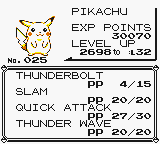
|
|---|---|
| Screen 1 | Screen 2 |
Generation II
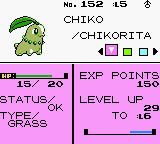
|
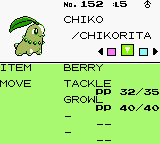
|

|
|---|---|---|
| Screen 1 | Screen 2 | Screen 3 |

|
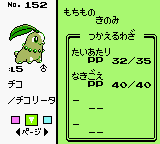
|
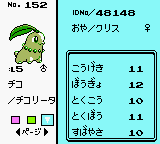
|
| Screen 1 (Japanese) | Screen 2 (Japanese) | Screen 3 (Japanese) |
Generation III
Pokémon Ruby and Sapphire
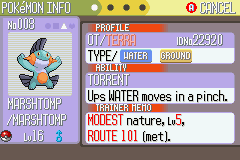
|
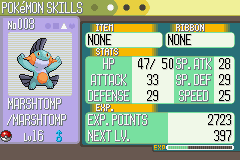
|

|
|---|---|---|
| Pokémon Info | Pokémon Skills | Battle Moves |

|
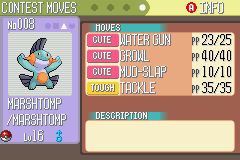
|

|
| Battle Moves (move description) |
Contest Moves | Contest Moves (move description) |
Pokémon Emerald

|

|

|
|---|---|---|
| Pokémon Info | Pokémon Skills | Battle Moves |
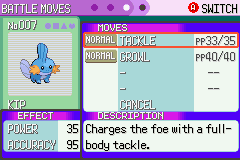
|

|

|
| Battle Moves (description) |
Contest Moves | Contest Moves (description) |
Pokémon FireRed and LeafGreen

|
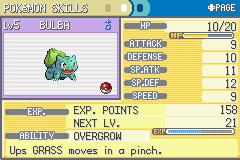
|

|

|
|---|---|---|---|
| Pokémon Info | Pokémon Skills | Known Moves | Known Moves (description) |
Generation IV
Pokémon Diamond, Pearl, and Platinum
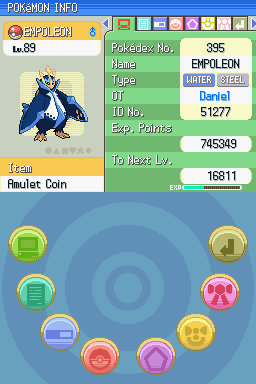
|
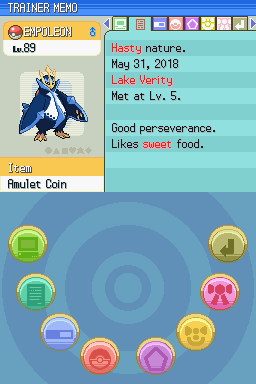
|

|

|
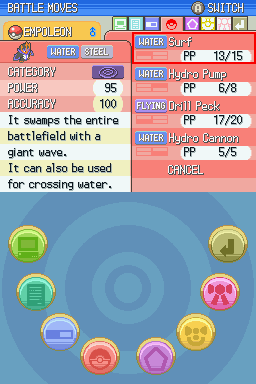
|
|---|---|---|---|---|
| Pokémon Info | Trainer Memo | Pokémon Skills | Batttle Moves | Batttle Moves (description) |

|
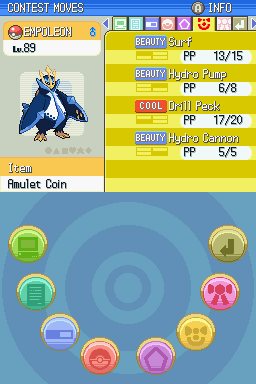
|
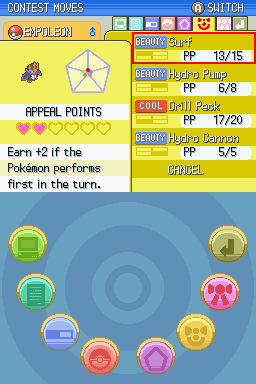
|

|

|
| Condition | Contest Moves | Contest Moves (description) |
Ribbons | Ribbons (description) |
In battle
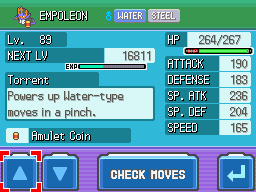
|

|

|
|---|---|---|
| Summary | Check Moves | Check Moves (description) |
Pokémon HeartGold and SoulSilver

|
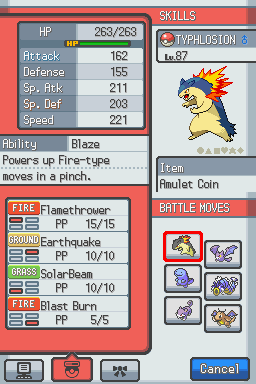
|
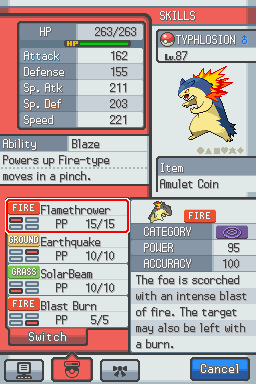
|
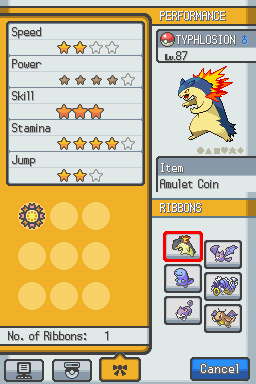
|

|
|---|---|---|---|---|
| Trainer Memo; Info | Skills; Battle moves | Skills; Battle moves (description) |
Performance; Ribbons | Performance; Ribbons (description) |
In battle
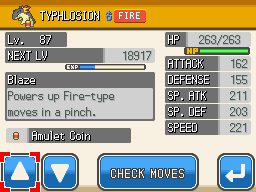
|
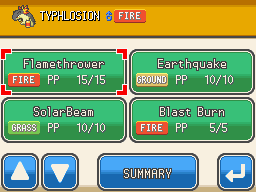
|

|
|---|---|---|
| Summary | Check Moves | Check Moves (description) |
Generation V

|
This section is incomplete. Please feel free to edit this section to add missing information and complete it. |
Pokémon Black and White
Pokémon Black 2 and White 2
Generation VI

|
This section is incomplete. Please feel free to edit this section to add missing information and complete it. |
Pokémon X and Y
Pokémon Omega Ruby and Alpha Sapphire
Generation VII

|
This section is incomplete. Please feel free to edit this section to add missing information and complete it. |
Pokémon Sun and Moon
Pokémon Ultra Sun and Ultra Moon
Pokémon Let's Go! Pikachu and Eevee
Generation VIII
Pokémon Sword and Shield

|
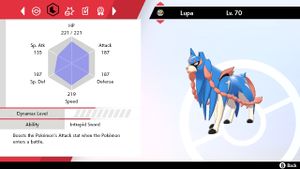
|
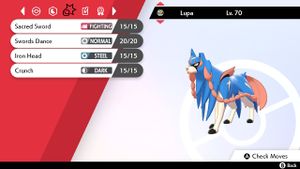
|
|---|---|---|
| Screen 1 | Screen 2 | Screen 3 |
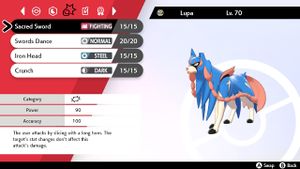
|
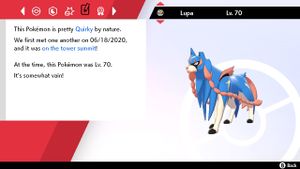
|

|
| Screen 3 (move description) |
Screen 4 | Screen 5 |
In battle
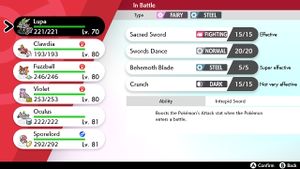
|
|---|
| Summary |
Trivia
- In game manuals, the word "summary" is usually written in lowercase (or all-caps "SUMMARY" like in the game interface). However, the manual of Pokémon Platinum inconsistently uses either "Summary" or "summary".
- In Generation I and II, the abbreviation ":L" is shown before the Pokémon's current level, and also in the text displaying how much experience is required to the next level. For instance, ":L25" means "level 25". However, level 100 is shown as just "100", without ":L".
In other languages
- Generations I and II
| ||||||||||||||||||||||||
- from Generation III to Ultra Sun and Ultra Moon
| ||||||||||||||||||||||||
- Let's Go! Pikachu and Eevee, Sword and Shield
| ||||||||||||||||||

|
This game mechanic article is part of Project Games, a Bulbapedia project that aims to write comprehensive articles on the Pokémon games. |